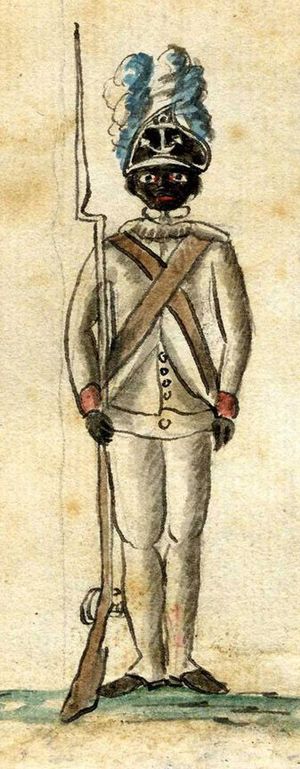Silas Royal facts for kids
Silas Royal (born in the 1740s, died 1826) was an amazing person who played a part in the American Revolutionary War. He was born enslaved and was first known as Silas Varnum. Later, he became a free man and a patriot who fought for America's freedom. He served in the Continental Army and also as a privateer, which was like being a sailor on a special armed ship.
Contents
The Varnum Family and Freedom
Silas Varnum grew up with the Varnum family in Dracut, Massachusetts. He was a servant to a young boy named J.B. Varnum. The Varnum family had different ideas about slavery than many people at the time. They believed that African Americans should be allowed to fight in the army. J.B. Varnum and Silas became good friends. Later in life, J.B. Varnum even helped create a law in Congress to stop the slave trade.
When Silas became an adult, the head of the Varnum family decided to set him free. As a freedman, Silas could have left, but he chose to stay and work for pay. He changed his name to "Silas Royal" to celebrate his new freedom.
Fighting for Freedom: War Service
When the war started, Silas Royal joined the army near Boston. James Mitchell Varnum, who was J.B. Varnum's brother, was put in charge of a group called "Varnum's Regiment." Silas joined this group as a trusted helper to General Varnum. He earned a lot of respect. Varnum's Regiment fought in the Battle of Bunker Hill. This group later became the 1st Rhode Island Regiment, which was special because most of its soldiers were African American and Native American.
Later, Silas Royal became a privateer on a ship called the Franklin. Privateers were like armed ships that helped disrupt British supply lines during the Siege of Boston. This job was risky but could also be rewarding. Silas once earned £30, which was a lot of money, from a captured ship. Soldiers called Marines from the Marblehead Regiment, many of whom were also Black, were on this ship. Silas might have joined these marines during George Washington's famous crossing of the Delaware River.
A Difficult Time: The Kidnapping
In 1778, Silas Royal had a problem with another sailor over money he had earned from a captured ship. This sailor took Silas and stole his money. Then, the sailor wrongly claimed Silas was his slave and sold him to a man named John White, who bought and sold enslaved people in Woburn. Both men ignored Silas's freedom papers, which proved he was a free man.
Silas was in great danger of being sent to the South to work on a plantation. He was handcuffed and put in a wagon on the road. Silas called for help, but the wagon moved too fast for anyone on foot to catch up. Luckily, the Varnum family heard about what happened and quickly gathered a group to rescue him.
John White knew Silas Royal was free, but he lied and said Silas was a runaway soldier and a thief. J.B. Varnum used his influence to talk to the authorities and successfully got Silas released. The Varnums even reported White's bad behavior to his bosses in Boston. They told White that he knew Silas was free and that he was wrong to treat him that way. They said Silas was an honorable man and that they would sue White for falsely imprisoning Silas.
After this, J.B. Varnum helped Silas file a lawsuit against John White. The court decided that Silas was right and awarded him £100 in damages.
Later Life and Legacy
After these events, Silas Royal returned to the Varnum home. He lived there as a free man for the rest of his life. In his will, J.B. Varnum made sure that Silas would be cared for and given an "honorable burial" after he passed away. Silas died on May 3, 1826, and was buried in the Varnum family cemetery in Dracut.
Images for kids


